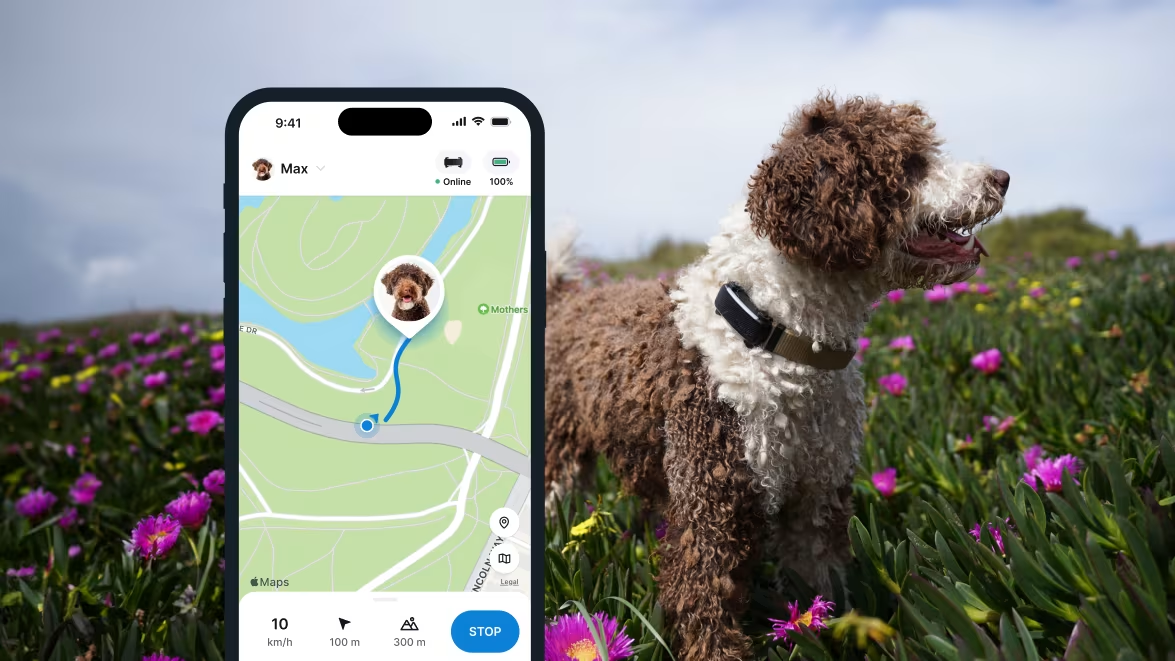How To Leave Your Dog Home Alone, 100% Stress-Free
With a little planning and prep, you can help your dog learn that it isn't a scary experience - and that they've got plenty to keep them occupied indoors!

Leaving dogs home alone can be heartrending. Dogs see us as members of their pack, but it’s not always possible (sadly) to spend all of our time with our furry pals – especially when you’ve got work, on holiday, or if the sitter cancelled last minute. Which is why it’s best to teach our dogs while they’re still puppies that being home alone is not a big deal.
So how to keep your pup happy and safe when you’re not around? How long is too long to leave your dog home alone? And how can you best keep an eye on them when you’re not around? Here’s how you can get started.
Key Takeaways
Never leave your dog alone without preparing them first. It’s a good idea to get them tired out with some fun playtime or a walk before you head out the door.
It’s important to train your dog to be comfortable when you’re not there. You can do this by practicing leaving and coming back so they learn that you will always return.
To help your dog feel less stressed, you can give them something to do while you’re away, like a toy that dispenses food. Make sure to leave a radio or the TV on so they don’t feel so lonely.
The Tractive smart dog tracker can help keep an eye on your dog when you’re away. It can let you know if they are barking too much or acting restless, which are signs that they might be feeling anxious without you.

Always know your buddy is healthy & safe
Read more- Key Takeaways
- How long is too long when leaving a dog home alone?
- What to consider before leaving your dog home alone
- What can happen when your dog is left home alone?
- 3 things to do before leaving dogs home alone
- How to train your dog to be home alone
- Tips to keep your dog busy at home when you’re not around
- How can I keep an eye on my dog while I’m away?
How long is too long when leaving a dog home alone?
Here are some general recommendations for how long you can leave your dog home alone, based on age:
| Age | Time spent alone |
|---|---|
| Puppies | 2 hours a day, max. |
| Adult dogs (over 18 months) | 4 – 6 hours a day. |
| Senior dogs | 2 – 6 hours. |
Puppies in general aren’t used to being home alone. They need to pee more and can develop separation anxiety. On the other hand, adult dogs might be more likely to adapt to being home alone. They might learn to sleep when you are not home.
For senior dogs, it can depend. Does your elderly dog experience health issues? For example, do they need to pee more frequently? Senior dogs might also be more likely to wander away from home.

Follow your dog anywhere
Get real-time location information, wherever they go. And find out when they try to make an escape, or just when they go somewhere they shouldn’t, with Virtual Fences.
What to consider before leaving your dog home alone
Before you head outdoors, keep in mind these factors that can affect how long you can leave your dog home alone:
- Age
- Health condition and issues
- Emotional needs, including whether they have separation anxiety
- Training and behavior
- Potty breaks – and your dog’s bladder control
- Feeding times
- Exercise and activity
- Socialization
- Other animals in the house
- Whether your dog has enough food when left alone
- What your dog has to keep them occupied while you’re gone
How long your dog can safely stay home alone depends a lot on their age, personality, and emotional and physical needs. But in general: try to keep the time that your dog is left home alone to a minimum. Even the most well-adjusted dogs may become distressed if they are left home alone for too long.¹
What can happen when your dog is left home alone?
For some dogs, being left home alone might be no big deal. For others, it may lead to one or more of the following distressing behaviors, which might indicate that your dog is bored, anxious or stressed out by being home alone.
- Scratching
- Biting
- Chewing on furniture and clothes
- Binge eating
- Getting lost
- Whining, howling, and barking
- Urination
- Running away
3 things to do before leaving dogs home alone
When you leave the house for work or leisure without your dog, you should first do the following:
- Leave your dog in an area where they feel comfortable.
Once your buddy gets more used to being left alone at home, they can then be on their own without any restriction. - Exercise your dog.
Like with a long walk or vigorous playtime. This can ensure they might just sleep off most of your absence. - Don’t skip out on your dog’s training.
Regular training can also help your dog get both a physical and mental workout. It also keeps their obedience skills sharp over time.
How to train your dog to be home alone
Proper training is essential when teaching your dog to be home alone – as early as when you first bring them home. In these cases, practice the “Leave and return” scenario. This will help teach your pup that being home alone is safe and a-okay – and that you WILL come back. Here are some steps to get you started:
- Put your shoes on and go to the door.
- If you notice your dog panicking, try to ignore it, so they get used to it.
- Repeat this action at least 3 times every day.
- As soon as you come back home, avoid giving your dog a warm welcome immediately at the door. Doing this will send your puppy the signal that coming home is just a normal, business-as-usual thing. Not an event worth celebrating (though deep down in your heart, you know it is!)
- After arriving home, command your dog to “Sit.” After they follow your command and settle down, welcome them calmly and let them feel your affection.
“When leaving home, if I say goodbye to my dogs, they want to come with me. So I just leave without saying anything – and they’re OK with it.“
– Marina Selinger, UX Designer at Tractive & certified dog trainer
Tips to keep your dog busy at home when you’re not around
Use food-dispensing toys instead of the classic food bowl. Some of these toys offer variable difficulty levels so you can make it a long-lasting project and keep your dog active and engaged during the time you’re away. You could also leave the TV or radio on for your dog if it may be soothing to them. Or try a YouTube video that’s designed for dogs.
Leave your dog small tasks and fun toys to play with when you’re not around to avoid unwanted boredom behavior (like biting and peeing in inappropriate places). However, never leave your dog alone with a toy that could be chewed apart and swallowed. You could also consider adding a second pet to the family so your dog isn’t bored when you’re not there.
When you return home from leaving your dog home alone, dedicate some time to your pup and don’t hold back with the love and attention. Remember: getting your dog used to you leaving and returning home is the best way to help them learn not to freak out once you do need to be away!
How can I keep an eye on my dog while I’m away?
Set up a pet camera
With a pet camera, you can check in on your dog throughout the day (and even dispense treats!) via a live video stream. Some even include two-way audio so you can talk to your dog and they can hear your voice. Pet cameras are a great way to keep an eye on your dog’s activity and behavior, especially when you’re at work or running errands.
Just be mindful that not all dogs might react so positively to your disembodied voice. (Like if your pet camera doesn’t include a visual of you.) Some might even spook or feel scared or anxious if they can hear you, but can’t see you! So if you want to invest in a pet camera, consider getting one that includes a webcam where your dog can see you and feel more comforted.
Hire a trusted dog walker or sitter
When you’ll be gone for extended periods, a professional dog walker or sitter can give your dog some company, keep them walked and exercised, and help them feel less lonely. If a pro isn’t in your budget, try and get a friend, neighbor, or family member to check up on them periodically. (Especially for potty breaks.)
If your dog has a GPS tracker strapped to their collar, the sitter can even share their real-time location with you – so you can check where your dog is with just a glance at your phone.

Use a smart dog tracker with integrated Bark Monitoring
If your dog has separation anxiety, a smart dog tracker can help provide an extra pair of eyes (and ears) on their activity and even barking when you’re not around. Strapped to your dog’s collar, your trusty Tractive device comes with a built-in volume sensor to pick up on changes in your dog’s vocalization. For example, if your dog tends to bark out of anxiety (compared to regular barking), your tracker can alert you if it’s excessive or accompanied with other signs of separation anxiety, like restless pacing.

Plus, if you set up the Separation Anxiety monitor via the app, your tracker can now alert you to signs of anxiety – like restless pacing:

And that’s not all. With a Tractive device strapped to your dog’s collar, you can also:
- Set up a “safe zone” around your home and backyard – and get an escape alert if your buddy ventures past it.
- Track your dog’s movements in real-time and over an unlimited range, in case they do escape home and end up bolting.
- Share your dog’s real-time location with friends, family, and neighbors. (Or vice versa.)
- Figure out your dog’s most frequented spots via their Heat Map and Location History.
- Keep track of your dog’s sleep and activity minutes – and pick up on to a change that much quicker.
All this in one device – built with love for dogs and for your peace of mind as a dog parent.



